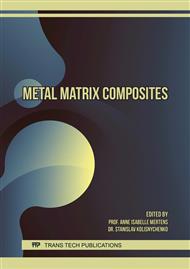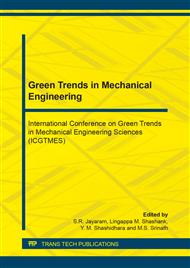p.102
p.109
p.115
p.122
p.127
p.134
p.139
p.144
p.152
Study on Surface Roughness in Minimum Quantity Lubrication Turning of Al-6082/SiC Metal Matrix Composites
Abstract:
Aluminum-based metal matrix composites (MMCs) have been suggested due to intense interest from automobile, marine, aerospace and other structural applications owing to their balanced mechanical, physical and chemical properties. MMCs are manufactured in order to meet present demand such as low material density, high mechanical strength and higher wear resistance of the component. Generally,MMCs tend to form rougher surface during machining because of the abrasive nature of hard ceramic particles present in them. Stir casting technique was used for fabrication of this composite which ensures better homogeneity.Furthermore, an attempt has been made in this paper to examine the results on the surface roughness of Al-6082/SiC metal matrix composites (containing 0%, 5% and 10% SiC particles).Focus was spent on parametric optimization of these composites in order to achieve cost-effective machining limits. The machining parameter studies have been carried out through the design of experiments (DoE) under minimum quantity lubrication (MQL) condition and effect of machining parameters such as spindle speed, feed rate and depth of cut on surface roughness was investigated to analyze the influence of reinforcement on surface roughness. In addition, analysis of variance was studied to obtain percentage contribution of machining parameters involved. Also, the surface morphology of the machined surface was studied through a scanning electron microscope (SEM). Distribution of SiC in aluminum alloy is fairly uniform with few clusters. Results of the experiments revealed that most significant turning parameter for surface roughness was spindle speed followed by feed rate and depth of cut. Furthermore, an optimal setting parameter for getting lower surface roughness was presented in confirmation table.
Info:
Periodical:
Pages:
127-133
Citation:
Online since:
November 2019
Authors:
Keywords:
Price:
Сopyright:
© 2019 Trans Tech Publications Ltd. All Rights Reserved
Share:
Citation:



